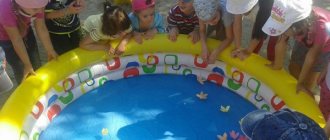Preparatory group. Senior preschool age. Children 6-7 years old
Summary of the lesson on FCCM in the preparatory school group "New Year's toys"
summary for the senior group “New Year’s toys”
Goal: expanding children's understanding of the traditions of celebrating the New Year in Russia.
Objectives: - introduce children to the history of New Year's toys;
- show the variety of materials when making New Year's toys; -... Notes on educational activities in the preparatory correctional group for the FCCM “Zoo” Notes on the educational field “ Cognitive Development ”
section:
“
Acquaintance with the environment ” on the topic:
“Zoo”
in the preparatory correctional group V-l: Mitroshina L.A.
2019 Integration of educational areas: “
Cognitive development ” ,
“Speech development”
,…
Games for children 6 years old to get to know the world around them
The goal of all these games is to introduce future first-graders to the beauty of the world around them. These games contribute to the development of horizons and expand the range of knowledge about the world.
This section contains games that introduce the child to his surroundings.
They develop certain skills, but are mainly designed to show how diverse and excitingly interesting the world is around us. Even ordinary things can be surprising if you look at them from an unusual point of view.
Everything is in place
Required equipment: soft toy or doll.
◈ Play on behalf of the doll, ask why this or that thing is needed and where it belongs.
◈ Invite the child to talk about some object (where it is, what it is made of, what it is needed for, how to care for it). Involve your child in joint activities.
Road traffic
Necessary equipment: small cars and figurines of people or animals (you can take figurines made from chocolate eggs).
◈ Surely you have already told your child many times about how to behave on the road.
◈ Draw a small town on a piece of Whatman paper with streets, houses, shops, road signs, etc. Let residents into this city - figures and cars. Using their example, again show the rules of behavior on the road (including for drivers): how to cross the street, explain what the road signs mean, how cars indicate that they will make a turn.
Prove it!
The game promotes the development of speech, memory, the ability to analyze, present and defend arguments
◈ Start the game like this:
♦ “It seems to me that the calf’s mother is a horse. After all, they have hooves, they are covered with hair, they eat hay,” etc. Encourage the child to explain to you that the calf is the baby of a cow, not a horse: a horse has no horns, a calf has no mane, a horse neighs, a calf moos, etc. . P.
♦ “A sparrow has a beak and feathers, which means its mother is a chicken.” Counterfactuals: different sizes, the sparrow flies - the chicken does not, the sparrow chirps - the chicken cackles, clucks, etc.
◈ Continue playing with your baby, gently helping him to draw one conclusion or another. You can contrast different objects and categories, for example, “a bear lives in a hole,” “bread grows on a tree,” etc.
◈ Each game should be brought to its logical conclusion so that the baby forms the correct images of the objects you are considering.
What am I doing?
The game promotes the development of attention and imagination
◈ Invite your child to play an interesting game: you will imitate certain actions, and he must guess what you mean by this. For example: you fold your fingers as if holding a pencil and move your hand along an imaginary paper. The baby must guess that you are “drawing” or “writing”.
◈ A child of this age should be shown simple gestures that are understandable to him (knock with a hammer, eat with a spoon, drink from a cup, throw a ball, etc.).
◈ Swap roles: let the baby show you some action.
Candle factory
Necessary equipment: candle stubs, threads, dishes for heating wax.
◈ Place the cinders in a fireproof container and melt them over low heat. After the wax has cooled a little, but has not lost its plasticity, spread it in an even layer on small rectangular sheets of paper, put a wick thread and roll it up - the candle is ready.
◈ To give it an original shape, soft wax with a thread in the middle can be placed in any vessel, be it a wine glass with intricate curves or a mold for playing in the sand.
◈ Draw your child’s attention to how wax changes from solid to liquid when heated.
◈ When melting wax, be very careful; to avoid injury, do not allow your child to take the container with the hot mass.
Attraction
Required equipment: magnet (preferably two magnets).
◈ Show your child a magnet, talk about its properties, and clearly demonstrate the ability of a magnet to attract metal objects. Test the surrounding objects for “attracted or not attracted.”
◈ Show your child the “magnetic theater”: place a paper clip or other light metal object on a sheet of paper or a plastic plate and run the magnet along the back of the sheet.
◈ Give your child the opportunity to act independently.
Let
Required equipment: magnet, thick fabric.
◈ Invite your child to conduct an experiment: cover a paperclip or other metal object with a cloth, and bring a magnet. The fabric prevents the object from being attracted to the magnet. Replace the fabric with a sheet of paper. And now?
◈ Give your child the opportunity to experiment by creating obstacles from different materials.
◈ At the end of the game, summarize the information received.
Rainbow on the wall
Necessary equipment: basin with water, mirror.
◈ Wait for a sunny day, place the container with water so that the sun's rays fall on it. Place the mirror at an angle of 25°. “Catch” a ray of sunshine with a mirror. As a result of the refraction and reflection of the ray from the mirror, a rainbow will appear on the wall.
◈ You can demonstrate a rainbow to your child at home by placing a crystal wine glass on a white sheet of paper. In this case, the sun's ray should fall directly on the wine glass.
◈ Explain to your child that the rainbow in the sky is also the result of the refraction of sunlight that occurs after rain.
Color the flower
Necessary equipment: cut flowers, preferably with white petals.
◈ Take a cut flower; for greater clarity, use flowers with white petals (narcissus, lily, carnation). Place it in water with dye diluted in it. After a few hours, you will be able to admire the flower, which will take on the color of the dye added to the water.
◈ Explain to your child that the water that the flower “drinks” rises along the stem all the way to the bud.
Conservation of mass of matter
Necessary equipment: small scales, two identical pieces of plasticine or clay.
◈ Examine both pieces of plasticine. What are they? The same. Invite your child to verify this by weighing the pieces on a scale.
◈ Change the shape of one piece by stretching it out. Ask your child if this part of the plasticine has become larger?
If the child answers in the affirmative, re-weigh - the mass of plasticine remains the same, which means that the change in shape did not affect this parameter of the substance, the pieces are still the same.
◈ What can be done to make one piece of plasticine different from another? (Tear off a small portion.) Demonstrate by weighing the resulting fragment on a scale.
Little volcano
Necessary equipment: plasticine, table vinegar, baking soda, red dye, soap solution.
◈ Make a cake out of plasticine - this will be the base of the volcano, on it place a hollow plasticine cone with a hole at the top - the volcano itself. Prepare “lava”: mix one part of soap solution and soda, add a few drops of dye. Pour the resulting mass into the “volcano” and add vinegar there.
◈ As a result of the interaction of acid and alkali, a violent reaction will begin, and “lava” - colored foam - will flow from the hole (the “vent” of the volcano).
◈ When conducting the experiment, be extremely careful to ensure that the acid does not get on your skin or clothing. And do not forget that the “reagents” should be stored out of the reach of children.
Salt crystal
Necessary equipment: salt, water, glass, thread or wire.
◈ Prepare a supersaturated salt solution (dissolve the salt in warm water until it stops dissolving). Dip a thin wire with a loop at the end into it.
◈ Leave it in the solution for several days and you will see how the wire becomes overgrown with salt crystals.
The candle is breathing
Necessary equipment: small candle, transparent glass.
◈ Light the candle, taking all precautions. Draw the child's attention to free burning.
◈ Cover the candle with a glass and watch the flame gradually become weaker and go out.
◈ Explain that combustion requires oxygen.
Secret letter
Necessary equipment: paper, brush, a little milk or lemon juice and iodine.
◈ Invite your child to write a secret message. Dip a brush in milk and write a few words on white paper. Dry the writing and then show your child how the letters appear after you hold the paper over hot steam.
◈ For safety reasons, do not let your baby develop letters on his own.
◈ Invisible writing can also be created with “lemon” ink. Instead of milk, use lemon juice, and instead of steam, use pharmaceutical iodine. After the inscription has dried, moisten it with a weak iodine solution (a few drops per glass of water).
Water transformations
Necessary equipment: ice molds, curly molds.
◈ Tell your child that water placed in the freezer freezes and turns into ice. Demonstrate this clearly.
◈ Show your child the ice figures, draw his attention to the fact that the pieces of ice repeat the shape of the vessels that you filled with water.
◈ Watch the ice melt. By adding paints to water, you can get multi-colored ice and make beautiful patterns out of it.
Walk in the woods
Required equipment: cards with images of trees.
◈ Lay out cards with images of trees (birch, aspen, oak, maple, etc.). Invite your child to take a walk in the forest. To make it more interesting for him, “ask” a bunny (fox, bear cub) to accompany you.
◈ Passing by the trees, the little animal tells the baby about the name of this or that tree, describes its appearance, the shape of its leaves and fruits. Asks the child questions: How can you distinguish a birch from an oak? Which tree has the thickest trunk? What tree do acorns grow on?
◈ While walking, look at the trees growing near your house, collect several leaves from different trees, compare them with each other, note the differences, paying attention to color, shape, size.
◈ Invite your child to make an observation diary, sketching trees, their leaves and fruits in it. Next to each picture, write the name of the tree in large font.
Collect a tree
Required equipment: pictures of trees
◈ Draw three different trees (oak, birch, maple). Cut them out and cut each tree into three parts: root, trunk, crown. Mix the parts. Invite your child to collect trees.
◈ Explain the functions of each part of the plant: roots absorb nutrients from the soil, they rise along the trunk to branches and leaves, leaves help the tree breathe and purify the air. Think with your child about the benefits trees bring.
Similar articles:
Outdoor games for children 6 years old
Development of logical thinking of a 6 year old child
Math games for a 6 year old child
Outdoor games for children from 6 to 7 years old
Development of imagination in 6 year old children
Presentations (card index) presentation for a lesson on the world around us (senior group) on the topic
Slide 1
“Primroses” Environmental project MBDOU “Novokarakan combined kindergarten” Konovalov group Compiled by: Elena Pavlovna Popova
Slide 2
Authors: Popova Elena Pavlovna – teacher of category II The purpose of the project: to give an idea of early flowers - primroses. Objectives: To consolidate the idea of spring and its signs. Development of children’s cognitive abilities in the process of joint research activities. To consolidate and systematize children's knowledge about garden and wildflowers. Foster love and respect for nature Intensify joint activities of parents and children
Slide 3
Relevance: Children do not have enough understanding of primroses, why they are called that, and where and how they grow. They cannot always accurately and completely explain the meaning of familiar words or select adjectives and verbs for nouns. Children's stories are not complete enough. The project solves the problem of increasing children's speech activity, improving coherent speech, and developing vocabulary. Type of project: educational and research, group, medium-term.
Slide 4
Participants: teachers, children, parents. Duration: 2 weeks. Integration of educational areas: cognition, music, communication, physical education, artistic creativity, reading fiction.
Slide 5
Expected result: Children will acquire the necessary knowledge on the topic: “Primroses.” Forming a sustainable interest in nature through environmental games, creating the “Primroses” album, and compiling brochures. Enriching children's vocabulary. Having created a collection of environmental fairy tales and theatrical performances. Development of a subject-development environment.
Slide 6
Stage 1 Preparatory Project activity Objectives Implementation deadlines Study the level of knowledge on the topic Determine children's current knowledge about primroses, spring flowers A week before the start of the project Selection of methodological literature Methodological support for the project Within a week before the start of the project Selection of fiction Information support for the project Within a week before the start project Production of teaching aids on the topic Providing the project with visual materials During the week before the start of the project
Slide 7
Stage 2 Intensive Ecological games “Run to the named flower”, “Find out by description” Game “Say a word” D/exercise. “Select and name the flowers you know”
Slide 8
Educational conversation; Reading the story “Violet” by N. Usova Compiling the story “Spring in the Forest”
Slide 9
Conversation about “Primroses” Reading the fairy tale “Twelve Months” to children
Slide 10
Modeling “Tulip” Modeling “Flower Meadow”
Slide 11
Non-traditional drawing “Coltsfoot” Application “Snowdrops for Mom” Creating an album for viewing “Spring Flowers”
Slide 12
Listening to music by Vivaldi 1 concert “Spring”, Tchaikovsky “Seasons” “Spring” Playing with elements of labor activity “I will plant seeds”
Slide 13
Stage 3 Final Exhibition of Children's Works.
Slide 14
Travel game “Visiting the Primroses”



